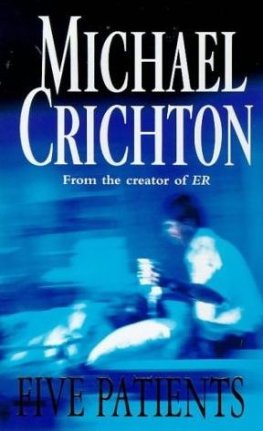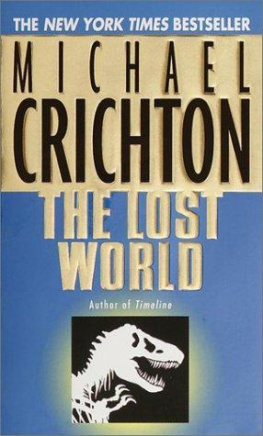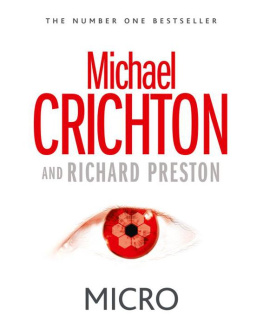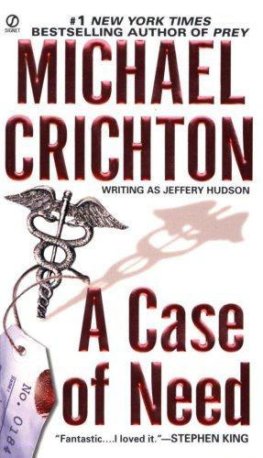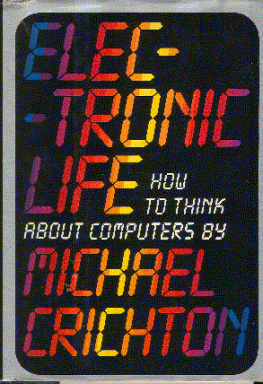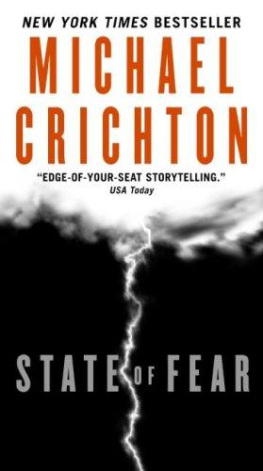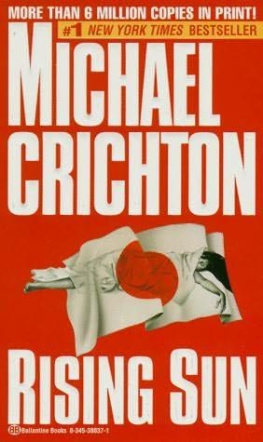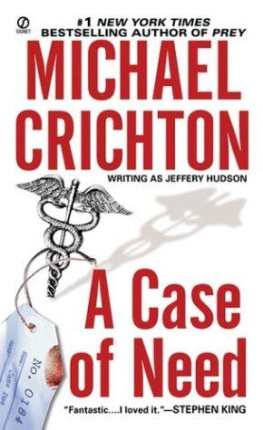Michael Crichton - Five Patients
Here you can read online Michael Crichton - Five Patients full text of the book (entire story) in english for free. Download pdf and epub, get meaning, cover and reviews about this ebook. genre: Detective and thriller. Description of the work, (preface) as well as reviews are available. Best literature library LitArk.com created for fans of good reading and offers a wide selection of genres:
Romance novel
Science fiction
Adventure
Detective
Science
History
Home and family
Prose
Art
Politics
Computer
Non-fiction
Religion
Business
Children
Humor
Choose a favorite category and find really read worthwhile books. Enjoy immersion in the world of imagination, feel the emotions of the characters or learn something new for yourself, make an fascinating discovery.
- Book:Five Patients
- Author:
- Genre:
- Rating:4 / 5
- Favourites:Add to favourites
- Your mark:
- 80
- 1
- 2
- 3
- 4
- 5
Five Patients: summary, description and annotation
We offer to read an annotation, description, summary or preface (depends on what the author of the book "Five Patients" wrote himself). If you haven't found the necessary information about the book — write in the comments, we will try to find it.
Five Patients — read online for free the complete book (whole text) full work
Below is the text of the book, divided by pages. System saving the place of the last page read, allows you to conveniently read the book "Five Patients" online for free, without having to search again every time where you left off. Put a bookmark, and you can go to the page where you finished reading at any time.
Font size:
Interval:
Bookmark:
Michael Crichton
Five Patients
Health, as a vast societal enterprise, is too important to be solely the concern of the providers of services.
William L. Kissick, M.D.Author's Note 1994
Twenty-five years have passed since I wrote Five Patients. When I reread the book recently, I was struck by how much in medicine has changed-and also, by how much has not changed. Eventually I decided not to revise the text, but to let it stand as a statement of what medical practice was like in the late 1960s, and how issues in health care were perceived at that time.
By design, the book is highly selective, and some of the most dramatic social changes in medicine were not anticipated in its discussions. This book was written before the great government interventions of Medicare and Medicaid; before the onslaught of malpractice litigation, which transformed medical practice; before the rise of group practices and HMOs; and before the entry of large numbers of women into the profession as physicians. At the time this book was written, abortion was illegal; patient rights were barely discussed; the right to die was only beginning to emerge as an issue for the future; and genetic testing was still an exotic, experimental procedure.
At the same time, the description in Five Patients of life in the emergency room seems little different from the present day; the training of new doctors is largely unchanged; the influence of medical history on present attitudes remains as important now as it was then; and the struggle to master new technologies, and to mount new surgical techniques, seems entirely contemporary.
Much of the book focuses on emerging technologies, and it is interesting to see how cutting-edge technologies in the 1960s have fulfilled, or failed to fulfill, their promises. The use of closed-circuit television for "remote doctoring" has not found wide application, but some observers think that this is because the technology is still emerging, and will reach fruition when a combination of robotics and virtual reality allow surgery to be performed by a surgeon thousands of miles away.
Similarly, I was fascinated by the idea that the computer might provide a powerful diagnostic tool, but diagnostic computer systems have found little acceptance in medicine. Doctors don't trust them and patients don't like them; they would rather give case histories to a paramedic or aide. On the other hand, everyone accepts automated lab tests, which are quick, accurate, and inexpensive. But overall, the effect of automation in medicine has been mixed; for example, even the mundane use of computers for hospital record-keeping has proven unexpectedly problematic, as our society struggles with issues of accuracy and privacy in the era of electronic data.
What was not foreseen by me, or by anyone else in the late 1960s, was that computers would soon become almost unimaginably cheap. A computer that cost ten million dollars in 1970 cost only a few thousand dollars in 1980, and only a few hundred dollars in 1990. Ubiquitous, cheap computer power has made possible a variety of non-invasive imaging procedures-computer assisted tomography, magnetic resonance imaging, and sonography- which have transformed the daily practice of medicine, and which seem, to someone from that era, almost magical in their results.
As medical technology has proliferated we have gained more sophisticated understanding of its limitations. Indeed, one trend in medicine has turned away from technology altogether. The long-term improvement in statistics for heart disease is primarily credited to life-style changes in the population. Diet, exercise, and meditation are now solemnly prescribed where once they were laughed at. And the growing interest in psychoimmu-nology, the interaction of mind and disease, is shared by patients and physicians alike. (When I wrote Five Patients, the most famous doctor in America was probably Michael DeBakey, the Houston cardiac surgeon. Now, he may very well be Deepak Chopra.)
It's also true that events in the larger world have upset the confident expectations for continuously improved health. Smallpox has been banished forever, but the appearance of Legionnaire's Disease, Lyme Disease, and particularly AIDS reminds us that new illnesses have always arisen throughout human history. During this past quarter century, we have come to know even more horrific pathogens, such as Eboli virus, which fortunately have not taken hold in Western societies. But the threat remains.
Skyrocketing medical costs were an issue in the late 1960s, as they are today, although our concern about expenditures in that era now seems quaint. Back then, the United States spent 6 percent of our GDP on health care-about 50 billion dollars annually. I predicted that figure would reach more than 100 billion by 1975. (In fact, it was 132 billion in that year.)
But no one back in 1969 would have foreseen the present astronomical level of expenditure: more than 800 billion dollars a year on health, more than 14 percent of our GDP, with no end in spending growth in sight. The reason was that, back then, nearly everyone imagined that the country would have long since moved to a national health plan, if only to contain costs. Our failure to do so has produced all sorts of unhappy consequences for our nation, ranging from diminished global economic competitiveness to new individual fears in the workplace. Half of all personal bankruptcies in America now result from health costs, and the need to maintain insurance coverage has transformed the work decisions of all Americans, greatly diminishing our once-prized personal mobility.
When I wrote Five Patients, a room at the Massachusetts General Hospital cost $70 a day. Now it costs more than $700. The hospital's annual operating budget was then $35 million a year. Now it is $732 million, far exceeding the rate of inflation for that period.
The need to control costs, while ensuring health care for all Americans, now dominates every discussion about the future shape of medicine in America. This country must finally adopt some form of national health insurance, as every other industrial country in the world has long since done. It is a complex and a difficult issue, even without its political dimension, which often seems to render it almost insoluble.
But while the systems of other countries are not without their problems, the fact is that other industrialized nations spend less on health care and get more for their money. At the moment, our national debate on health care is in the phase of blame and recrimination. We are told that doctors are paid too much, or that lawyers and litigation cost too much, that pharmaceutical companies charge too much, and so on. But the truth is that everyone works within the constraints of the present system-and it is the system itself that must be changed.
One can draw an analogy to the earlier complaints about the cost and quality of American automobiles, which at one time were blamed on American workers. But the reality is that workers on the assembly line are prisoners of a system designed by others. Individual effort cannot significantly affect the outcome of the system. Only by changing the assembly line itself-by changing the way cars are designed and made-can a better product result. And given a better process, American workers have proven that they are as productive and efficient as anyone else.
Similarly, American medicine has grown up as an unplanned entrepreneurial system of individual providers. The current system does many things well, but at high cost. A growing proportion of that cost derives from legislation passed by American politicians, who are not accountable for costs they impose. Indeed, freedom from political accountability is one of the worst features of the present American system.
Font size:
Interval:
Bookmark:
Similar books «Five Patients»
Look at similar books to Five Patients. We have selected literature similar in name and meaning in the hope of providing readers with more options to find new, interesting, not yet read works.
Discussion, reviews of the book Five Patients and just readers' own opinions. Leave your comments, write what you think about the work, its meaning or the main characters. Specify what exactly you liked and what you didn't like, and why you think so.

